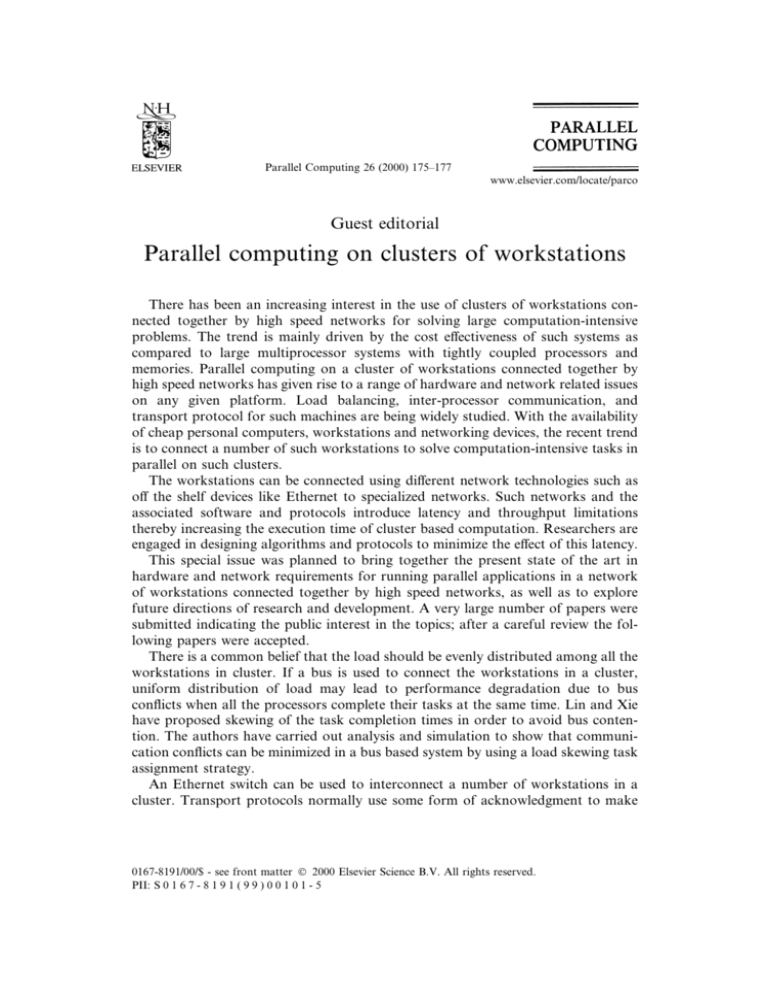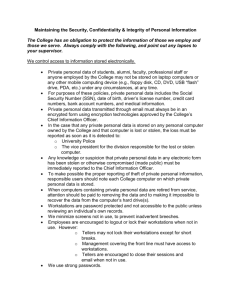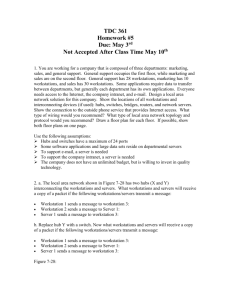
Parallel Computing 26 (2000) 175±177
www.elsevier.com/locate/parco
Guest editorial
Parallel computing on clusters of workstations
There has been an increasing interest in the use of clusters of workstations connected together by high speed networks for solving large computation-intensive
problems. The trend is mainly driven by the cost eectiveness of such systems as
compared to large multiprocessor systems with tightly coupled processors and
memories. Parallel computing on a cluster of workstations connected together by
high speed networks has given rise to a range of hardware and network related issues
on any given platform. Load balancing, inter-processor communication, and
transport protocol for such machines are being widely studied. With the availability
of cheap personal computers, workstations and networking devices, the recent trend
is to connect a number of such workstations to solve computation-intensive tasks in
parallel on such clusters.
The workstations can be connected using dierent network technologies such as
o the shelf devices like Ethernet to specialized networks. Such networks and the
associated software and protocols introduce latency and throughput limitations
thereby increasing the execution time of cluster based computation. Researchers are
engaged in designing algorithms and protocols to minimize the eect of this latency.
This special issue was planned to bring together the present state of the art in
hardware and network requirements for running parallel applications in a network
of workstations connected together by high speed networks, as well as to explore
future directions of research and development. A very large number of papers were
submitted indicating the public interest in the topics; after a careful review the following papers were accepted.
There is a common belief that the load should be evenly distributed among all the
workstations in cluster. If a bus is used to connect the workstations in a cluster,
uniform distribution of load may lead to performance degradation due to bus
con¯icts when all the processors complete their tasks at the same time. Lin and Xie
have proposed skewing of the task completion times in order to avoid bus contention. The authors have carried out analysis and simulation to show that communication con¯icts can be minimized in a bus based system by using a load skewing task
assignment strategy.
An Ethernet switch can be used to interconnect a number of workstations in a
cluster. Transport protocols normally use some form of acknowledgment to make
0167-8191/00/$ - see front matter Ó 2000 Elsevier Science B.V. All rights reserved.
PII: S 0 1 6 7 - 8 1 9 1 ( 9 9 ) 0 0 1 0 1 - 5
176
Guest editorial / Parallel Computing 26 (2000) 175±177
the transport mechanism reliable. Donaldson, Hill and Skillicorn have proposed a
reliable transport protocol which maximizes the switch performance. Their scheme
uses a receiver driven protocol and a ®ne grained acknowledgment reduction technique. It has been argued that performance similar to high performance machines
can be obtained at a fraction of the cost by using networks of workstations connected by an Ethernet switch.
The paper by Brightwell, Frisk, Greenberg, Hudson, Levenhagen, Maccabe and
Riesen describes a 96-node prototype of a massively parallel computational architecture which has been built at Sandia National Laboratory using o the shelf
computing and networking hardware. Performance results of parallel benchmark
codes have been presented with indication of problems in building such a massively
parallel machine.
In a network of workstations, it is important to utilize the available computing
power to its fullest potential, i.e., not to let the workstations idle as long as there are
ready tasks. The paper by Melab and Talbi describes a method to automatically
distribute tasks to idle workstations in a network of workstations. They have provided experimental results for the eciency of their scheme by using examples like
Gauss Jordan algorithm. In a distributed computing environment, bandwidth and
latency of the underlying network are the usual bottlenecks for achieving high
throughput. Chu and Dowd, in their paper, propose a cache coherence protocol to
reduce the eects of latency. Simulation results have shown better performance of
their protocol as compared to previous protocols.
Blum, Wang and Leung have studied the architecture of cluster and message
passing algorithms and their eects on the performance of workstation based cluster
computing. They have also investigated new network topologies and message
passing software systems which could reduce latency. Test results have been presented to demonstrate that the new architecture and software result in very fast
systems.
Dierent types of networks can be used to connect a number of processors in a
workstation cluster. The delays introduced by the communication layers in the operating system is usually a bottleneck. Chiola and Ciaccio have described a fast
communication layer for 100Base-T based workstation clusters.
A number of primitives such as multi-cast and barrier synchronization have been
implemented. One of the challenges in network based computing is the parallel
implementation of DO-ACROSS loops. Many compiler optimization techniques
have been proposed to parallelize DO-ACROSS loops while keeping the communication overhead low. Liu and King have proposed a methodology to parallelize
DO-ACROSS loop at runtime in a network of workstations environment. It uses
multi-threading to hide latency. The authors have demonstrated the usefulness of
their technique using a number of Alpha workstations connected together using a 10
Mbps Ethernet.
Guest editorial / Parallel Computing 26 (2000) 175±177
177
We are grateful to the Regional Editor, Professor Robert Hiromoto and the
Editor-in-Chief, Professor Dr. Gerhard R. Joubert, for their guidance through the
whole process. We thank the large number of authors who submitted papers for this
special issue and we gratefully acknowledge the eorts of the reviewers who spent
their valuable time to provide reviews in a timely fashion.
11 October 1999
Mohammed Atiquzzaman
Department of Electrical and Computer Engineering,
University of Dayton,
Dayton, OH 45469, USA
E-mail address: atiq@ieee.org
Pradip K. Srimani
Department of Computer Science,
Colorado State University,
Ft. Collins, CO 80523, USA
E-mail address: srimani@cs.colostate.edu










